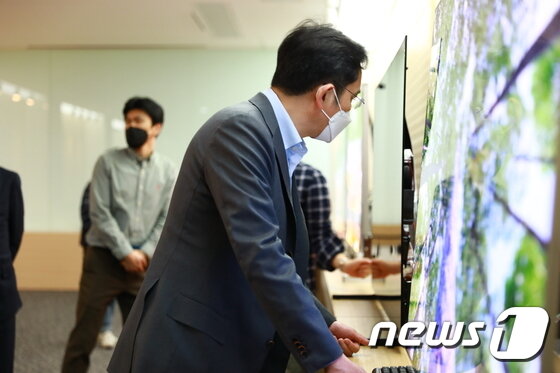 |
| Samsung Display’s Suzhou LCD production line (provided by Samsung Display) © News1 |
It was found that the government approved the sale of Samsung Display’s LCD (liquid crystal display) production line in Suzhou, China.
Since the ‘8.5th generation’ LCD technology used in the Suzhou plant is a national core technology, it needs to be approved when relocating overseas, but it can be interpreted that there is no problem as a result of deliberation by experts.
Accordingly, it is expected that Samsung Display’s business reorganization, which is focusing on developing new technology based on quantum dot (QD), is expected to gain momentum.
According to the government and related industries on the 5th, the Ministry of Trade, Industry and Energy decided to hold the Industrial Technology Protection Committee the day before and approve the agenda of’selling the LCD factory in Suzhou, China’ which Samsung Display applied for.
The results of the committee were immediately delivered to Samsung Display, and it was reported that Samsung immediately initiated follow-up measures.
Earlier, in August of last year, Samsung Display signed a contract to sell all shares of its LCD production line in Suzhou with TCL of China. The sale price is 1.08 billion dollars (about 1.27 trillion won).
This is the only 8.5G LCD panel production line that Samsung Display owns in China, and it is known to have a production capacity of up to 160,000 sheets per month.
Since 2019, Samsung Display has been considering withdrawal of the LCD business step by step in order to overcome the sluggishness of large displays caused by intensifying competition in the LCD market.
 |
| Samsung Electronics Vice Chairman Lee Jae-yong is looking at products at Samsung Display’s Asan plant in Asan, Chungnam on March 19, 2020. (Provided by Samsung Electronics) March 19, 2020/News 1 |
Then, in October 2019, led by Vice Chairman Lee Jae-yong, invested 13 trillion won in Asan, Chungcheongnam-do, announced a plan to advance into the next generation’QD Display’ and started developing new foods.
As part of this plan, Samsung Display proceeded to sell its 8.5th generation LCD fab located in Suzhou.
However, the problem is that the technology applied to the Suzhou LCD factory, which Samsung Display was trying to sell to TCL, is the’national core technology’ designated by the government.
National core technology refers to an industrial technology that has a high technical and economic value occupied in the domestic and overseas markets, and is likely to adversely affect the national security and national economy if it is leaked overseas.
Currently, there are two national core technologies in the display sector, one is active organic light-emitting diode (AMOLED) panel design, process, and manufacturing (excluding module assembly process), and the other is the 8th generation (2200x2500mm) or higher TFT-LCD panel. It is a design/process/manufacturing/drive (excluding module assembly process) technology.
According to the Act on the Prevention and Protection of Industrial Technology Leakage, matters related to the export of national core technology and overseas acquisitions and mergers of the holding institutions must go through deliberation by the Industrial Technology Protection Committee under the Ministry of Trade, Industry and Energy.
Accordingly, the government initiated a review of Samsung Display’s application through a display field expert committee from the second half of last year, and final approval was decided only in February this year.
In the display industry, it is analyzed that in the LCD sector, which gave the lead to China, the government will also strengthen its strength so that domestic companies can accelerate their’escape strategy’ and at the same time reinforce competitiveness around next-generation technologies such as QD and OLED (organic light-emitting diodes).
 |
| A view of Samsung Display’s Asan plant. (Provided by Samsung Display) © News 1 |
![[단독]Government approves Samsung Display to sell LCD fab in Suzhou, China [단독]Government approves Samsung Display to sell LCD fab in Suzhou, China](https://image.news1.kr/system/photos/2013/10/25/640144/article.jpg)